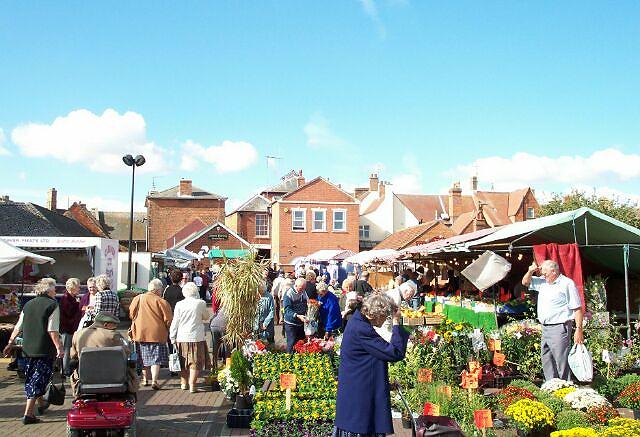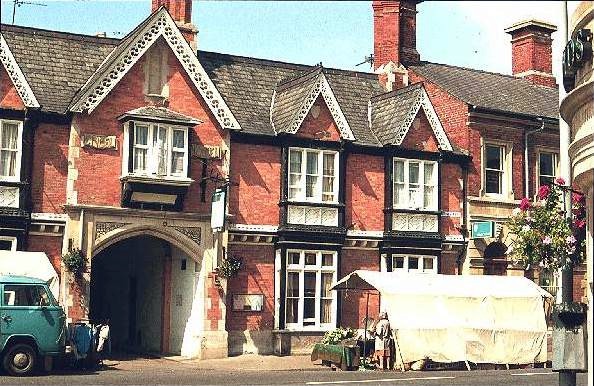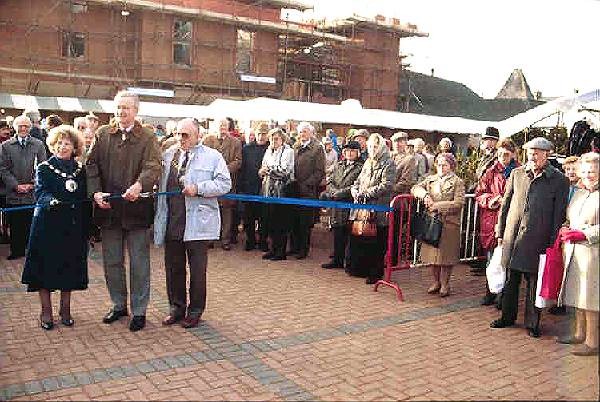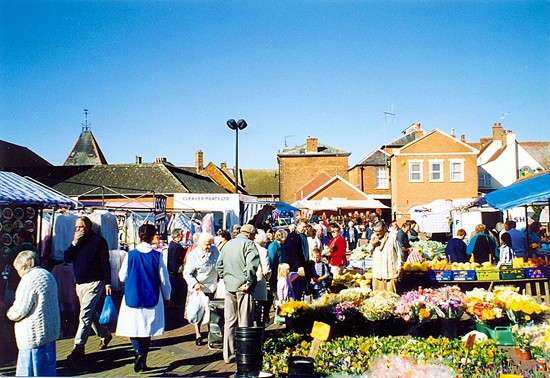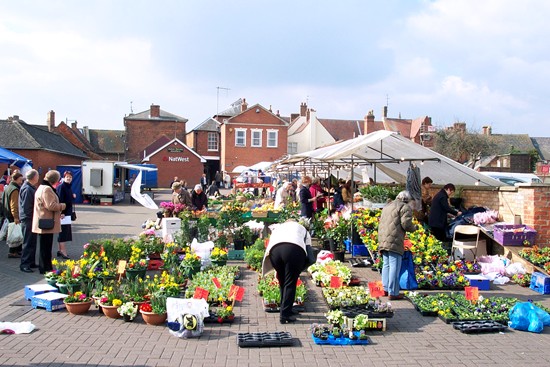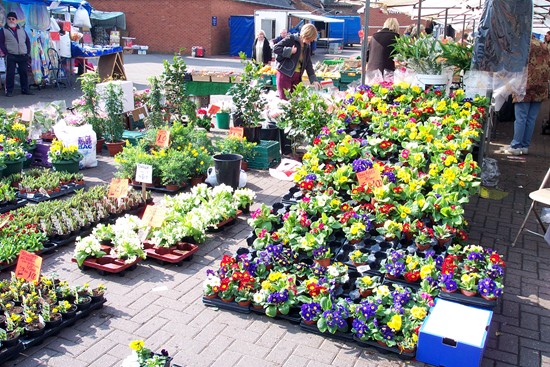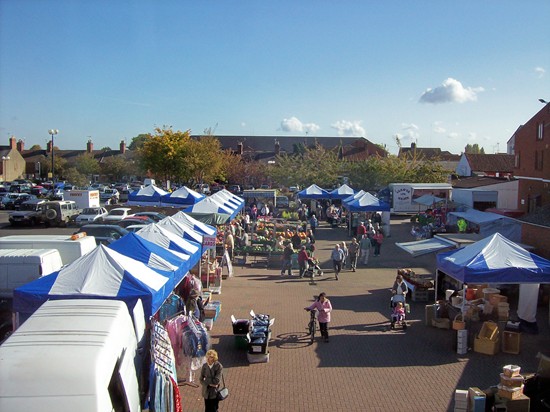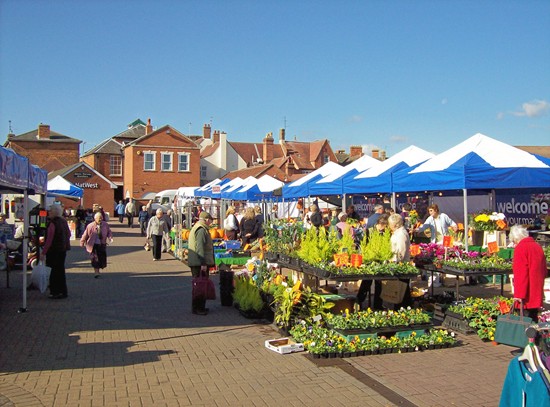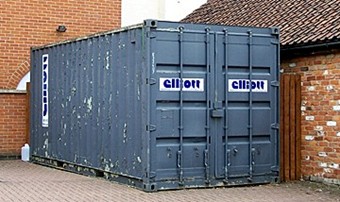|
The market
A market has been held in Bourne for more than 700 years under a royal charter granted to the Lord of the Manor of Bourne, Baldwin Wake, by King Edward I in 1279. The original charter document, dated two years later, is now in the British Museum. It gave permission for a market to be held on a Saturday and this tradition continues today although a Thursday market was later added and this has become the more popular of the two. Many similar market towns were being established in England at this time and although the number was seriously reduced by the Black Death, many flourished again and during the period 1500-1650, Bourne was one of thirty-seven market towns in Lincolnshire, specialising in one particular commodity, namely corn. The main markets handling this commodity were generally situated near navigable rivers and we can assume that the Bourne Eau was already being used for transport and that this continued well into the 19th century. Weekly markets were the main places for trading in England and almost all had a market cross around which goods and produce were sold such as butter, cheese and poultry, and some had several, hence the surviving name in many towns of the butter cross and its variations. This became the focal point of the village in times past, where the people gathered to gossip and exchange news and proclamations of important local and national events were made from this spot. There was also a well in the market place although its origins are vague but early photographs show a pump standing near to or over the site outside the Angel Hotel and its existence became apparent in recent years when excavations were carried out on the roadway in North Street. Shops in mediaeval Bourne were clustered mainly around the market place for this was the attraction that brought them their custom. Market stalls in those days were known as shambles and it was not always easy to distinguish them from the shops but by the 16th century, they were generally small premises erected for the sale of fish and meat and let out to townsmen and traders from other places on market days. For example, William Kent of Morton, who died in 1619, had a shop in the "Butchers' Shambles", indicating that it was not uncommon for country butchers to have a retail outlet in the adjoining market town. Shops were more permanent structures than shambles having wooden pentices or projecting covers that extended several feet into the street and they were open each day. Usually, they clustered around the market place and were often rented by the same families for several generations. Such craftsmen as shoemakers or tailors carried out their work under the pentice, visible to the public, with the master sitting in the centre and his apprentices on either side. By the early 19th century, the town hall in Bourne had become dilapidated and a site occupied by a house adjoining the Bull Inn [now the Burghley Arms] on the east side of the market place was chosen for a new building but this too was to have a shambles or set of stalls underneath, and from this arrangement sprang the eventual street market that became a familiar sight in the town during the 20th century. The market place was also the venue for the annual fairs that were held in Bourne and these were a more elaborate version of the weekly markets, although also dealing in livestock such as horses, cattle and sheep. The annual statute fairs for the hiring of servants was also held here, although this was not strictly a fair but was derived from the mediaeval Statutes of Labourers of which the first was enacted in the reign of Edward III (1327-1377) when there was a shortage of agricultural workers. Most of the English charter fairs had their origins in Norman and subsequent times but may even have been held much earlier, going back to the days of the Roman occupation and the name itself, fair, is derived from the Latin feria meaning a holiday. These fairs sprang from the entertainments and amusements provided by itinerant showmen and performers who flocked here to delight the crowds attracted by the markets and the hiring of servants. It is likely that Bourne had only one fair a year in the Middle Ages but eventually there were three, held on March 7th, May 6th and October 29th and by the end of the 19th century there was also a fourth on September 30th. Today, there is only one annual fair and it is confined to pleasure only, a fun fair that arrives every October and is held on a local car park, clinging precariously on to its past traditions but unlikely to survive long into the 21st century. The weekly market was an occasion for both buying and socialising and the situation was similar to that we see today although during earlier times, even until the 1950s, 60% of those who attended the market travelled between one mile and five miles to get there. Goods were brought in for sale from the farms and villages and tradesmen would arrive to display their wares in the shambles. Local shopkeepers and craftsmen would also have an eye to business by trying to attract custom from the visitors who had arrived for the day and who often depended on the market town for the supply of those goods which they could not obtain at home. But the market itself was strictly regulated with toll-gatherers and other officials who checked the quality and the price of goods for sale. Market hours would also be fixed and there were other regulations to ensure fair play: no one, for instance, could sell their corn until other merchants had arrived from neighbouring villages. But buying and selling were not the only activities in town on market day. The taverns were always busy while farmers and their wives would gather to hear the latest news and gossip, to discuss their various illnesses, exchange opinions on the topics of the day and even to criticise the government. The manorial rights in Bourne were subsequently
acquired by the Cecil family whose distinguished member William Cecil was the
first Lord Burghley, and this entitled his descendants, the Marquesses of Exeter,
as Lords of the Manor of Bourne, to receive the market rents. Towards the end of
the 18th century, the markets and fairs appear to have fallen into disuse but the building of the new Town
Hall in 1821 coupled with a growing expansion of the town, brought with them a
new civic pride and inspired the marquess and George Pochin, Lord of the Manor
of Bourne Abbots, together with a group of farmers and landowners, to revive the
tradition.
1. That in consequence of the great number of cattle
bred and fed in the neighbourhood, and from the great quantity of corn and
other agricultural produce supplied from a large tract of fertile land
surrounding the market town of Bourne, and from the extensive improvements and
accommodations recently made and now making there, it is of the opinion of this
meting that the town of Bourne affords a most convenient situation whereas to
hold fairs for the sale and purchase of cattle of all descriptions, and of all
other articles of agricultural produce. The chair being vacated, the thanks of the
meeting were unanimously voted to the chairman for his able conduct in the
chair, and to Mr Edwards, agent to George Pochin, Esq., for his zeal in
promoting the objects of the meeting. As a result, the market was reinstated on
Friday 29th October 1824 while the weekly corn market was held in front of the
Town Hall the following day from 12.30 pm until 1.30 pm. The market continued to thrive during the 19th century and in later years the collection of market tolls due to the Marquess of Exeter was delegated to the Moisey family and successive members carried out this duty until the then Marquess sold his ownership of the market rights to Bourne Urban District Council. After protracted negotiations with the Marquess over a number of years, there was some dispute over ownership and a meeting of ratepayers was held at the Town Hall on Thursday 3rd November 1921 to sanction the purchase. The main opponents to the transaction were members of the Moisey family but their claim to have held the market rights for more than three centuries was disputed. Alderman John T Swift, a noted local historian, was called in to give his opinion and he told the meeting that he had searched the church records but there was no such name as Moisey registered in Bourne 300 years before. James Moisey, who then collected the tolls, withdrew his claim after a private financial settlement from the Marquess. A survey of the market was carried out in October 1921, prior to the meeting of ratepayers in the Town Hall the following month, and it showed that there were 62 stalls at the weekly market occupying a frontage of some 225 yards. Suggested scales of stallage were laid down, e g 2½d. per lineal foot for ratepayers with a stall and 3d. for non-ratepayers. The importance and scale of the market to the town at that time appears in the minutes of Bourne UDC for May 1924 when it was decided to inform the Marquess that residents living in the vicinity were complaining about the late hour of closing on Saturday nights and suggesting that his Lordship give instructions for the stalls to be taken down at 10 pm, an indication that market hours tended to be very much longer than today. In 1923, Bourne Urban District Council renewed its attempt to buy the rights for the sum of £50 and a further approach was made in 1949 on the urging of the chairman, Councillor Thomas Revill, but negotiations on both occasions proved to be abortive and they remained with the Marquess and administered through the Burghley Estates for a further period before a successful agreement was arrived at in 1961. The rights subsequently passed to South Kesteven District Council in 1974 during the re-organisation of local government and this authority now collects the market tolls and is responsible for its administration.
Over the years, little has changed. The market continued in the town centre, along the western kerbsides in North Street and West Street, until the closing years of the 20th century when increasing traffic flows made road conditions too hazardous for shoppers and on Thursday 13th December 1990, it was moved to a purpose built paved area behind the town hall, planned as part of the Burghley Arcade and Corn Exchange developments on the site of the old cattle market that had closed in 1981. The move was marked by a civic ceremony at which the mayor, Councillor Stan Pease officiated, and a ribbon was cut by Councillor Ian Croft, chairman of South Kesteven District Council's amenities committee to herald the start of business. This was a significant day in the history of the market although traders were at first dubious about the move on the grounds that the new location would not attract sufficient custom but their fears have been unjustified and market days continue to be an occasion for buying bargains as well as creating a crowded social occasion, especially on fine summer days. The site for the new market is particularly relevant in the history of the town because the shambles or stalls incorporated in the plans for the new town hall of 1821 provide a direct link between our present modern market and that of past times.
See also Why the market should remain off the streets REVISED SEPTEMBER 2015 Go to: Main Index Villages Index |
||||||||||||||||||||||||||
